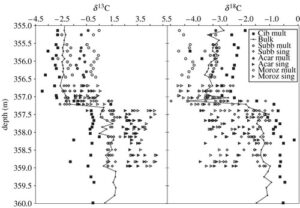The Palaeocene–Eocene carbon isotope excursion: constraints from individual shell planktonic foraminifer records
The Palaeocene–Eocene thermal maximum (PETM) is characterized by a global negative carbon isotope excursion (CIE) and widespread dissolution of seafloor carbonate sediments. The latter feature supports the hypothesis that the PETM and CIE were caused by the rapid release of a large mass (greater than 2000 Gt C) of 12C-enriched carbon. The source of this carbon, however, remains a mystery. Possible sources include volcanically driven thermal combustion of organic-rich sediment, dissociation of seafloor methane hydrates and desiccation and oxidation of soil/sediment organics. A key constraint on the source(s) is the rate at which the carbon was released. Fast rates would be consistent with a catastrophic event, e.g. massive methane hydrate dissociation, whereas slower rates might implicate other processes. The PETM carbon flux is currently constrained by high-resolution marine and terrestrial …

